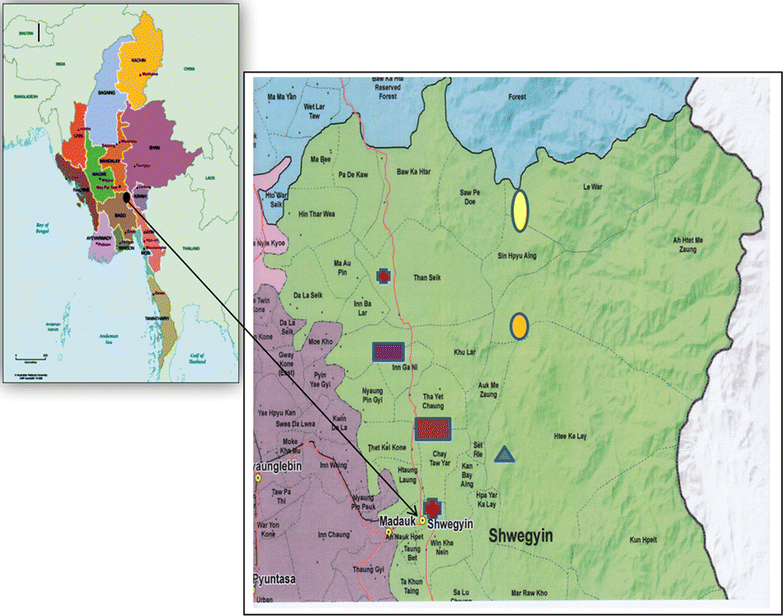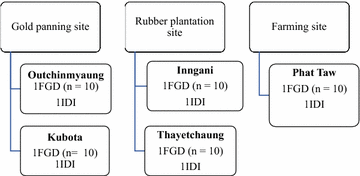Understanding malaria treatment-seeking preferences within the public sector amongst mobile/migrant workers in a malaria elimination scenario: a mixed-methods study
- PMID: 29132373
- PMCID: PMC5683526
- DOI: 10.1186/s12936-017-2113-4
Understanding malaria treatment-seeking preferences within the public sector amongst mobile/migrant workers in a malaria elimination scenario: a mixed-methods study
Abstract
Background: Migration flows and the emerging resistance to artemisinin-based combination therapy in the Greater Mekong Sub-region (GMS) create programmatic challenges to meeting the AD 2030 malaria elimination target in Myanmar. The National Malaria Control Programme (NMCP) targeted migrant workers based mainly on the stability of their worksites (categories 1: permanent work-setting; categories 2 and 3: less stable work-settings). This study aims to assess the migration patterns, malaria treatment-seeking preferences, and challenges encountered by mobile/migrant workers at remote sites in a malaria-elimination setting.
Methods: A mixed-methods explanatory sequential study retrospectively analysed the secondary data acquired through migrant mapping surveys (2013-2015) in six endemic regions (n = 9603). A multivariate logistic regression model was used to ascertain the contributing factors. A qualitative strand (2016-2017) was added by conducting five focus-group discussions (n = 50) and five in-depth interviews with migrant workers from less stable worksites in Shwegyin Township, Bago Region. The contiguous approach was used to integrate quantitative and qualitative findings.
Results: Among others, migrant workers from Bago Region were significantly more likely to report the duration of stay ≥ 12 months (63% vs. 49%) and high seasonal mobility (40% vs. 35%). Particularly in less stable settings, a very low proportion of migrant workers (17%) preferred to seek malaria treatment from the public sector and was significantly influenced by the worksite stability (adjusted OR = 1.4 and 2.3, respectively for categories 2 and 1); longer duration of stay (adjusted OR = 3.5); and adjusted OR < 2 for received malaria messages, knowledge of malaria symptoms and awareness of means of malaria diagnosis. Qualitative data further elucidated their preference for the informal healthcare sector, due to convenience, trust and good relations, and put migrant workers at risk of substandard care. Moreover, the availability of cheap anti-malarial in unregistered small groceries encouraged self-medication. Infrequent or no contact with rural health centres and voluntary health workers worsened the situation.
Conclusions: Mitigating key drivers that favour poor utilization of public-sector services among highly mobile migrant workers in less stable work-settings should be given priority in a malaria-elimination setting. These issues are challenging for the NMCP in Myanmar and might be generalized to other countries in the GMS to achieve malaria-elimination goals. Further innovative out-reach programmes designed and implemented specific to the nature of mobile/migrant workers is crucial.
Keywords: GMS; Malaria elimination; Migrant workers; Mixed-methods design; Myanmar; Public sector; Rural health centers; Voluntary health workers.
Figures



Similar articles
-
Spatial distribution, work patterns, and perception towards malaria interventions among temporary mobile/migrant workers in artemisinin resistance containment zone.BMC Public Health. 2014 May 17;14:463. doi: 10.1186/1471-2458-14-463. BMC Public Health. 2014. PMID: 24884534 Free PMC article.
-
Mobility dynamics of migrant workers and their socio-behavioral parameters related to malaria in Tier II, Artemisinin Resistance Containment Zone, Myanmar.BMC Public Health. 2015 Sep 14;15:886. doi: 10.1186/s12889-015-2241-0. BMC Public Health. 2015. PMID: 26370297 Free PMC article.
-
Knowledge, access and utilization of bed-nets among stable and seasonal migrants in an artemisinin resistance containment area of Myanmar.Infect Dis Poverty. 2017 Sep 14;6(1):138. doi: 10.1186/s40249-017-0353-8. Infect Dis Poverty. 2017. PMID: 28903759 Free PMC article.
-
Private sector opportunities and threats to achieving malaria elimination in the Greater Mekong Subregion: results from malaria outlet surveys in Cambodia, the Lao PDR, Myanmar, and Thailand.Malar J. 2017 May 2;16(1):180. doi: 10.1186/s12936-017-1800-5. Malar J. 2017. PMID: 28464945 Free PMC article. Review.
-
Multisectoral Approach to Support Use of Insecticide-Treated Net for Malaria Prevention Among Mobile and Migrant Populations in Myanmar: A Systematic Review.J Infect Dis. 2020 Oct 29;222(Suppl 8):S717-S725. doi: 10.1093/infdis/jiaa335. J Infect Dis. 2020. PMID: 33119095 Free PMC article.
Cited by
-
Emerging neglected helminthiasis and determinants of multiple helminth infections in flood-prone township in Myanmar.Trop Med Health. 2019 Jan 4;47:1. doi: 10.1186/s41182-018-0133-6. eCollection 2019. Trop Med Health. 2019. PMID: 30787669 Free PMC article.
-
Genetic polymorphisms in genes associated with drug resistance in Plasmodium vivax parasites from northeastern Myanmar.Malar J. 2022 Mar 3;21(1):66. doi: 10.1186/s12936-022-04084-y. Malar J. 2022. PMID: 35241080 Free PMC article.
-
Interventions for promoting patients' adherence to 14-day primaquine treatment in a highly malaria-endemic township in Myanmar: a qualitative study among key stakeholders.Malar J. 2023 Oct 9;22(1):302. doi: 10.1186/s12936-023-04743-8. Malar J. 2023. PMID: 37814267 Free PMC article.
-
A comparison of malaria prevention behaviours, care-seeking practices and barriers between malaria at-risk worksite migrant workers and villagers in Northern Shan State, Myanmar-a mixed method study.Malar J. 2022 Jun 3;21(1):162. doi: 10.1186/s12936-022-04193-8. Malar J. 2022. PMID: 35658947 Free PMC article.
-
The use of respondent‑driven sampling to assess febrile illness treatment-seeking behaviours among forest-goers in Cambodia and Vietnam.Malar J. 2021 Dec 20;20(1):477. doi: 10.1186/s12936-021-04001-9. Malar J. 2021. PMID: 34930264 Free PMC article.
References
-
- Jitthai N. Migration and malaria. Southeast Asian J Trop Med Public Health. 2013;44(Suppl 1):166–200. - PubMed
-
- WHO. Strategy for malaria elimination in the Greater Mekong Subregion: 2015–2030. Manila: World Health Organization Regional Office for the Western Pacific; 2015.
MeSH terms
Grants and funding
LinkOut - more resources
Full Text Sources
Other Literature Sources
Medical

